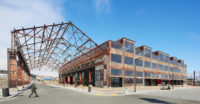John King Untangles the History of American Urbanism Through San Francisco’s Ferry Building
Excerpt: 'Portal: San Francisco's Ferry Building and the Reinvention of American Cities' by John King

In his latest book, two-time Pulitzer finalist and record contributor John King explores the history of American urbanism through the rise, fall, and rebirth of San Francisco’s Ferry Building. Conceived during the Gilded Age, this showcase of civic ambition was completed in 1898. Following is an excerpt from the first chapter.
There was no pressing need for a grandiose ferry terminal in the San Francisco of 1890, particularly one topped by a sky-piercing clock tower, and nobody back then claimed otherwise. Some people on arriving ferries were here to see the exotic metropolis that in 45 years had grown from a ramshackle hamlet of a few hundred residents into the nation’s eighth-largest city, but the vast majority of the riders spilling out toward Market Street were commuters en route to work from bayside cities to the east and north. They disembarked from stout vessels with wooden hulls and paddle wheels, belching smoke from dark chimney stacks. Passengers then strode briskly to cable-pulled street cars designed to ascend hills too steep for horse-drawn vehicles.
Even if someone were inclined to linger along the bay, there was little in the way of recreation or genteel attractions to reward their interest. This was the largest port on the West Coast, a cacophony of commerce with carriages rumbling back and forth over cobblestones and dirt, piled high with boxes and burlap sacks filled with everything from coffee beans to fresh pineapple. Some of these raw treasures had arrived from across the Pacific, perhaps Hawaii or the Philippines, others from the agricultural fields of California’s central valley. Across the way from the ferries was the produce district, a haphazard terrain of narrow, crowded streets.
Sights and sounds aplenty. Not a place for a casual stroll.
Nor was there anything majestic about the spot where most ferries had pulled in or departed for the past 15 years: Ferry House, a string of sheds behind a wooden front, the one embellishment being the names of destinations served by the Southern Pacific Railroad that were painted along the cornice. The railroad was the biggest tenant in the modest structure run by the Board of State Harbor Commissioners, the state agency that owned the Port: the Board had built this facility on the shoreline between Market and Clay streets in 1875 to remedy the “very inadequate accommodations” that existed prior, a polite reference to the wharves that jutted out from the muddy edge of the city wherever an operator had secured a perch. As for the structures the Ferry House would displace, the San Francisco Chronicle dismissed them as “a miserable lot of old tumbledown, rickety buildings,” and said that, with their departure, “it is to be hoped the fragrance of this neighborhood will be changed for the better.”

The Union Depot and Ferry Building were designed by A. Page Brown. Photo courtesy of the California Historical Society, click to enlarge.
Compared to excess and westward expansion, the low-slung sheds that constituted the Ferry House soon lost whatever novelty they had possessed. A full remake of the waterfront where ferries pulled in “cannot be pushed too rapidly to please the public-minded citizen,” wrote one local publication, the Criterion, in 1889. “The old rookeries that now stand in front of the city are its disgrace. They should be torn away with all possible speed.” And what might replace them? “A structure suitable to the great growth that the city is experiencing,” the Criterion proclaimed. “The city cannot have too many attractive edifices.”
The harbor commissioners were of similar mind—eager not just to crowd in more slips and sheds, but to erect a structure with an architectural character fitting for the city struggling to move beyond its raucous past. The commission put out a contract for a more substantial seawall section at the foot of Market Street that would include a solid concrete retaining wall to provide the beginnings of a foundation for a depot that was intended to serve as nothing less than “a stately passenger depot at the gateway to the ‘Metropolis of the Pacific.’”



